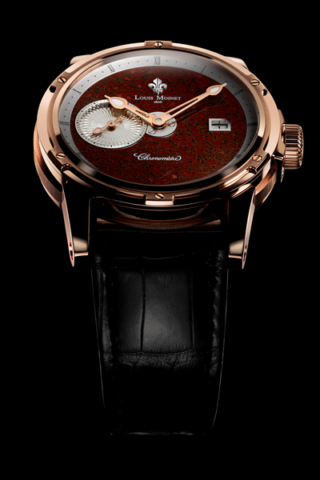As every fan of Ateliers Louis Moinet knows, the firm loves all things beautiful, unusual and exceptional. On its Mecanograph City watches, it was the first to include fragments of lunar meteorites and other rocks from the far-flung corners of the universe.
Meanwhile, the Treasures of the World collection has opened up another creative path: that of dials made from rare, fossilized stones of mineral or plant origin, includingpetrified exotic wood.
These two unique approaches have now been combined in the Jurassic Watch, derived from the Mecanograph family, is the first to feature a dial made from Jurassic-era dinosaur bone –between 145 and 200 million years old.
The mechanical heart of the Jurassic Watch is the certified Mecanograph chronometer. This proprietary movement has been exclusively developed by Ateliers Louis Moinet. This unique timepiece comes with a 43.5mm case made from rose gold. Date at 3 o’clock, seconds hand at 9 o’clock on the dial with a concentric Clou de Paris pattern, limited edition of 12 watches.

It boasts not only extraordinary precision, but also a dial made from a genuine fossilized 150-million-year-old dinosaur bone. In another first, the caliber features a date window located at 3 o’clock. It also uses the exclusive Energie Plus (*) process, unveiled by Louis Moinet at Baselworld.
Specific craftsmanship is vital for the production of each dial. It begins with the choice of the right stone; this needs to be sufficiently dense to be worked on, taking into account its final size and texture. The ensuing handiwork takes over a week – and results in a dial thickness of just 0.65mm.
The dinosaur bone in question, discovered in North America, has been authenticated by renowned geologist Dr Andreas Stucki in association with the Aathal Dinosaur Museum in Switzerland. The dinosaur bone is from the family of large herbivores, which also includes the Diplodocus.

Technical data sheet
Features and functions
Central hours & minutes
Small seconds
Date
Chronometer certified movement conceived by Louis Moinet
Dial and hands
Fossilized 150-million-year-old dinosaur bone dial
Central Gouttes de Rosée hour and minute hands, gold-treated
Small seconds hand at 9 o’clockon the dial with a concentric Clou de Paris pattern
Date at 3 o’clock
Fleur-de-lis applique
Movement and finish
Calibre LM34, an exclusive, automatic, COSC-certified, 182-component movement, conceived by Louis Moinet
Frequency: 28,800 vph / 4Hz
Lines: 13 ¼
Power reserve: 48 hours
Jewels: 26
Balance: Glucydur, screwed
“Energie Plus” system
Pawl winding mechanism
Pawl winding system: comprises a baseplate and two jewelled pawls
‘Crab claw’ spring mechanism
Gearing: automatic wolf-teeth gear
Ball bearing: 7 Myrox balls (ceramic), diameter: 0.397 mm
Oscillating weight: Bi-directional featuring Côte du Jura motif
Case and strap
Case: Louis Moinet design featuring six-screw bezel
Material: 18K rose gold
Diameter: 43.50mm
Thickness: 15.60mm
Water resistance: 50 metres
Case back:Secured with seven screws, engraved with individual number and Louis Moinet symbol
Crystals: Two sapphire crystals with anti-reflective treatment
Strap: Louisiana alligator leather, hand-sewn, 24mm width between lugs
Buckle: 18-carat pin buckle
Presentation box
Louis Moinet book
Limited editions
LM-34.50.01 12 watches 5N 18K rose gold Fossilized dinosaur bone
About Louis Moinet
Ateliers Louis Moinet was founded in Saint-Blaise, Neuchâtel, in 2004. The fully-independent firm was established to honour the memory of Louis Moinet (1768-1853): master watchmaker, certified inventor of the chronograph (1816), and pioneer in the use of very high frequencies (216,000 vibrations per hour). Louis Moinet was a watchmaker, scholar, painter, sculptor, and teacher at the School of Fine Arts – as well as the author of Traité d’Horlogerie, a watchmaking treatise published in 1848 and a work of reference throughout the rest of the nineteenth century. Ateliers Louis Moinet is perpetuating this legacy. The firm’s timepieces, produced in limited editions only, have won some of the most coveted awards, including a Red Dot Design Award (Best of the Best category), a prize in the International Chronometry Competition, and a recent UNESCO Award of Merit. Louis Moinet creations often make use of unusual materials, such as fossils and meteorites, in a unique creative approach combined with bespoke fine watchmaking complications. The brand’s core values are creativity, exclusivity, art and design.
